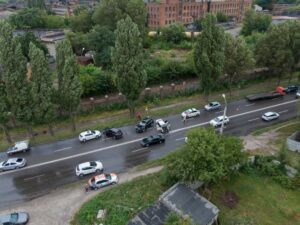Where Do Waco Car Accidents Most Occur?

You’re no stranger to the bustling streets of Waco and navigating its roads can be a bit like dodging obstacles. Car accidents happen, but knowing where they’re more likely to occur can give you the upper hand in staying safe. In this guide, we’ll break down the hotspots, the trouble zones, and the simple steps you can take to protect yourself and your loved ones.
Now, here’s the thing—these aren’t just facts; they’re your roadmap to safer driving. You’ve got the power to make a difference on Waco’s roads. So, whether you’re cruising down I-35, maneuvering through downtown, or taking it slow in your neighborhood, remember these tips.
Be aware. Be patient. Be the driver that makes a positive impact on Waco’s road safety. Accidents may happen, but with the right mindset and a bit of caution, you’re well on your way to steering clear of trouble. If you or a loved one has been injured in a car accident, reach out to an experienced Waco car accident lawyer for assistance.
Major Roadways: High Risk for Waco Car Accidents
Let’s start with the big players—the major roadways that crisscross Waco. Interstate 35, Highway 84, and other significant routes keep the city moving. But with the constant flow of vehicles and varying speeds, these roads are also hotspots for Waco car accidents. Keep your eyes peeled, maintain a safe following distance, and stick to the speed limits to steer clear of trouble.
Interstate 35
I-35, often referred to as the backbone of Waco’s transportation system, sees a constant ebb and flow of vehicles. The daily commute can range from steady to downright bustling, especially during peak hours. The south-to-north flow through the city means a mix of local and through-traffic, contributing to the overall dynamics.
With the heavy traffic volume, accident risks on I-35 are notable. High speeds, lane changes, and the convergence of local and interstate traffic create a setting where vigilance and defensive driving are paramount. Accidents, unfortunately, are not uncommon, making it crucial for drivers to exercise caution and adhere to traffic regulations.
Highway 84

Highway 84, a major east-to-west artery, intersects with I-35, forming a crucial crossroads for Waco. The traffic flow is generally moderate, catering to both local commuters and travelers passing through the city. It’s a road where diligence in navigation is key, especially at intersection points and areas where it interacts with other major roads.
Accident risks on Highway 84 are influenced by its role as a connecting route. Intersection trouble zones, changes in traffic patterns, and occasional congestion points can elevate the likelihood of accidents. Drivers should approach this roadway with a heightened sense of awareness, particularly at key junctures.
Downtown: Where Congestion Meets Collision
Downtown Waco is the heart of the action. It’s a hub for commuters, tourists, and locals alike. The convergence of these streams of movement creates a dynamic and often congested environment where navigating the streets demands both skill and caution. The mix of traffic can be overwhelming, and frequent stops and starts make accidents more likely. When navigating downtown, patience is your ally. Take your time, watch for pedestrians, and stay alert to the ebb and flow of traffic.
Factors Leading to Accidents in Downtown Areas
A primary contributor to accidents in Downtown Waco is the high volume of traffic moving across the city every day. The constant influx of vehicles in downtown Waco contributes to congestion, creating an environment prone to accidents. The urban landscape often means frequent stops at traffic lights, intersections, and pedestrian crossings, increasing the risk of Waco car accidents like rear-end collisions and fender-benders.
Busy downtown intersections can be intricate, featuring multiple lanes, turning options, and traffic signals. Misjudgments and misunderstandings can lead to collisions.
Downtown areas are also bustling with pedestrians exploring shops, attractions, and eateries. The mix of foot traffic and vehicles requires drivers to be hyper-aware to avoid accidents.
Intersection Trouble: Navigating Crossroads with Care
Intersections can be trouble zones, and Waco has its fair share. Certain crossroads see more action than others, and understanding the challenges they pose is key. Look out for unclear signage, complex layouts, and heavy traffic. When you approach an intersection, slow down, check your blind spots, and be ready for the unexpected. Identifying specific intersections prone to accidents and understanding the common challenges they pose helps motorists stay safe on the city’s streets.
Specific Intersections Prone to Accidents
- I-35 Frontage Road and University Parks Drive Intersection: This busy intersection experiences a high volume of traffic from the adjacent I-35, the university, and local roads. The complex layout and merging lanes contribute to the potential for accidents.
- Valley Mills Drive and Waco Drive Junction: A convergence of major roadways, this intersection witnesses a mix of local and through traffic. The challenge lies in the multiple turning options, leading to a heightened risk of collisions.
- Franklin Avenue and South 4th Street Crossing: Situated in downtown Waco, this intersection encounters a blend of pedestrians, cyclists, and vehicles. The presence of historic landmarks adds to the complexity, making it prone to accidents.
Common Challenges at Intersections
Intersections with multiple lanes, turning options, and merging traffic can be overwhelming. Drivers may struggle to navigate the intricate flow, leading to confusion and potential accidents.
Some intersections lack clear signage, causing uncertainty among drivers about the right of way, lane usage, and upcoming turns. Inadequate guidance increases the risk of collisions.
Downtown intersections often have a significant number of pedestrians. Balancing vehicle and foot traffic becomes challenging, especially during peak hours, raising the chances of accidents.
Certain intersections have visibility challenges, with obstructed views due to buildings, landscaping, or other structures. These blind spots make it difficult for drivers to anticipate oncoming traffic.
Residential Areas: The Surprising Risks Close to Home
You might not think twice about cruising through your neighborhood, but residential areas have their own set of risks. Speeding and distracted driving are common culprits. Keep it slow, stay alert for kids playing, and avoid distractions. Remember, the safety of your neighbors and loved ones depends on everyone being a responsible driver.
Accidents in residential areas in Waco can often be attributed to a combination of factors. Here are some common causes that contribute to Waco car accidents in residential neighborhoods:
- Speeding: Speeding through residential streets is a prevalent problem, jeopardizing the safety of both drivers and residents. Higher speeds reduce reaction time, making it more challenging for drivers to respond to unexpected obstacles or the sudden appearance of pedestrians.
- Distracted Driving: Distractions such as texting, talking on the phone, or adjusting in-car systems divert drivers’ attention from the road. Reduced focus on the surroundings increases the risk of collisions, especially in areas where children may be playing or pedestrians are present.
- Failure to Obey Traffic Signs and Signals: Ignoring stop signs, yield signs, or other traffic signals is a common problem in residential areas. Intersection accidents can occur when drivers fail to yield the right of way or disregard traffic control devices, leading to potentially serious collisions.
- Limited Visibility: Factors like parked cars, trees, or other structures can obstruct sightlines, making it difficult for drivers to see other vehicles or pedestrians. Limited visibility increases the risk of accidents, particularly at intersections or when backing out of driveways.
- Reckless Driving: Aggressive and reckless driving behaviors, such as tailgating or weaving through residential streets, pose significant dangers. Reckless driving increases the likelihood of accidents, puts residents at risk, and creates an overall unsafe environment.
- Failure to Yield to Pedestrians: Drivers not giving the right of way to pedestrians in crosswalks or at intersections. Pedestrians face an increased risk of being struck by vehicles, leading to injuries or fatalities.
- Inadequate Lighting: Poorly lit residential areas, especially at night, can make it challenging for drivers to see pedestrians, other vehicles, or potential hazards. Reduced visibility increases the chances of accidents, particularly in poorly illuminated areas.
- Impaired Driving: Driving under the influence (DUI) of alcohol or drugs is a serious concern in residential areas. Impaired drivers have compromised judgment and reaction times, significantly elevating the risk of accidents.
Understanding and addressing these common causes of accidents in residential areas is essential for promoting road safety. Both drivers and residents play a role in creating a secure environment through responsible driving habits and adherence to traffic regulations.
Construction Zones: Navigating Change in the Road
Waco is a city in motion, and that means ongoing construction. While improvements are in the works, construction zones increase the likelihood of accidents. Reduced lanes, altered traffic patterns, and uneven surfaces are par for the course. When driving through construction areas, patience and caution are your best friends. Stick to reduced speed limits, be aware of your surroundings, and don’t let impatience lead to accidents.
Construction zones in Waco pose increased accident risks for drivers. The mix of altered traffic patterns, reduced lane space, and the presence of heavy machinery demands heightened caution. Here’s a closer look at the potential risks and strategies for staying safe in construction zones.
Increased Accident Risks
Reduced Lane Space: Construction often leads to lane closures and narrower roadways. Reduced lane space increases the likelihood of congestion and accidents, especially when drivers attempt lane changes or merges.
- Altered Traffic Patterns: Construction activities may necessitate changes in traffic flow, such as detours and lane shifts. Sudden alterations in traffic patterns can catch drivers off guard, leading to confusion and a higher risk of accidents.
- Uneven Surfaces: Road surfaces in construction zones may be uneven, incomplete, or have temporary coverings. Uneven surfaces pose a risk of loss of vehicle control, particularly if drivers are not anticipating changes in road conditions.
- Presence of Construction Vehicles: Heavy machinery, construction trucks, and equipment moving in and out of the work area. The presence of construction vehicles creates additional hazards, and their movements may be less predictable than regular traffic.
Texas Traffic Accident Statistics
According to the Texas Department of Transportation (TxDOT), there were 15,769 serious injury crashes in Texas in 2021 with 19,456 people sustaining a serious injury. TxDOT reported the fatality rate on Texas roadways in the same reporting period was 1.58 deaths per hundred million vehicle miles traveled. The 2021 death toll was 4,497 people. There were no deathless days on Texas roads in 2021.
In Waco, there were 16 fatal crashes in the reporting year, as well as 106 suspected serious crashes with 118 suspected serious injuries, TxDOT reported.
Contact Lorenz & Lorenz Accident & Injury Lawyers PLLC

Ted R. Lorenz, Car Accident Attorney in Waco, TX.
If you’ve been involved in a Waco car accident, you don’t have to navigate the aftermath alone. Lorenz & Lorenz Accident & Injury Lawyers PLLC is here to guide you through the complexities of personal injury claims, providing the support and expertise you need during this challenging time. Our team has a history of successfully advocating for clients in personal injury cases, securing the compensation they deserve. Our experienced Waco personal injury attorneys will assess the details of your case, explain your rights, and outline a strategy to pursue justice and fair compensation. Call our Austin law office at (830) 251-4761 or complete our online contact form. Don’t let the impact of a traffic accident define your future—let Lorenz & Lorenz Accident & Injury Lawyers PLLC help you take the first steps toward healing and justice.
